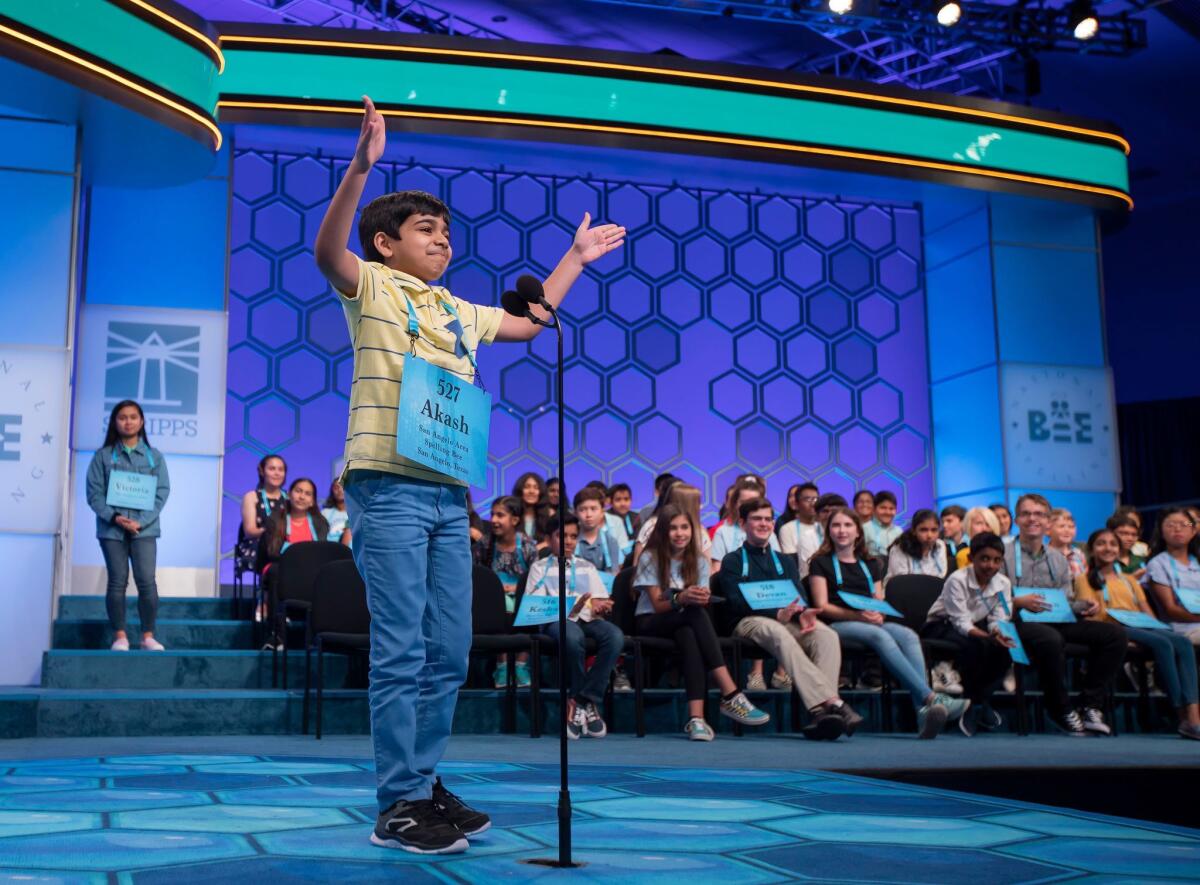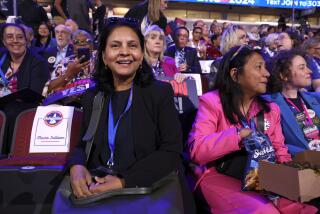Op-Ed: How Indian Americans came to dominate the National Spelling Bee

If the finals of the National Spelling Bee are upon us, so is the chatter about Indian American domination of the competition. Indian Americans have won every Scripps National Spelling Bee since 2008, a reign that is the result of a confluence of factors — feel-good documentaries that inspired future spellers, a culture invested in competitive spelling and parental investment in a child’s educational success.
Spelling bees have become a vital part of the Indian American experience. Although only a handful of the 4.4 million Indian Americans become elite spellers, the intense way they meet the challenge is transforming this quintessential American activity.
For the record:
9:00 a.m. May 30, 2019An earlier version of this op-ed incorrectly said Indian Americans have won every Scripps National Spelling Bee since 1998. They have won every bee since 2008.
The U.S. can lay claim to inventing the term “spelling bee,” which first appeared in print in 1875. But when the bee marks its 100th birthday in 2025, Indian Americans will get the credit for turning spelling into a highly competitive sport.
When viewers tune in to ESPN to watch Thursday night’s national finals of the bee, Indian American spellers will undoubtedly take the stage.
Indian American spellers often say the documentary “Spellbound” inspired them to treat the dictionary as less-than-casual reading. When the film showed Nupur Lala winning the 1999 national bee — with the word “logorrhea” — many of them decided to compete.
As an anthropologist doing research on the bee over six years, I kept hearing the same sentiment over and over: “If she can do it, we can do it.” But Indian American interest in competitive spelling predates “Spellbound.”
Such deep involvement in a language arts activity may seem unusual for an immigrant community known for its prowess in science, technology, engineering and math (STEM). But I learned there is community prestige in placing competitively in spelling bees and great familial pride for having participated in something so challenging at a young age.
Champions often are groomed on the spelling bee circuit. Nearly every Indian American speller who has won the National Spelling Bee over the last decade has also won or done well in the South Asian Spelling Bee, founded in 2008 and run by a public relations firm. The contest has its roots in a brainstorming session for an event that would draw South Asian American consumers. State Farm and MetLife have served as title sponsors.
Competing in bees also allows these young word nerds to make a vast social network of friends who also love spelling. For them, smart is definitely the new cool.
Since 1993, the nonprofit North South Foundation has enrolled Indian American children in a variety of bees, including spelling, vocabulary, math and geography. The 92 nationwide chapters were founded through word of mouth with no marketing or publicity — evidence of how this immigrant community shares information and knowledge about academic enrichment activities. More than 16,000 students compete each year.
It’s no secret that parents of Indian American elite spellers are deeply involved in their children’s spelling success, including paying for coaches and quizzing them for hours a day. This phenomenon was documented in the 2018 documentary “Breaking the Bee,” which showcased how Indian American competitors had come to dominate the event.
One elite speller featured in the documentary, Shourav Dasari, competed on the bee circuit for over a decade with his sister. When I asked their father, Ganesh, why the Indian American community put such emphasis on this activity, he replied: “The motivation probably comes from parents who grew up in a place where education can get you a lot.”
Through Indian American community involvement and word of mouth come more potential bee entrants. Many parents of Indian American spellers I met — including Dasari and his wife, Usha — earned STEM degrees in India that made them attractive to U.S. employers. They immigrated as part of the skilled migration solicited through the Immigration Act of 1990.
When their children aged out of the spelling bee competition in 2017, the Dasaris founded “SpellPundit,” a coaching company. It joins more established Indian American coaching enterprises, including “GeoSpell,” started by Dallas-area resident Vijay Reddy. When their son, Chetan, competed, Reddy and his wife programmed software and created extensive word lists for him. Chetan’s best national bee finish was seventh place. “We wanted him to win,” Reddy said. “It was our Olympics.”
The aptitude of these Indian American competitors has led to other changes behind the scenes of the national bee. Because entrants are so well-prepared, the overall difficulty of words has skyrocketed, with preliminary-round words now drawn straight from the dictionary rather than from pre-circulated word lists.
Enter the Fray: First takes on the news of the minute from L.A. Times Opinion »
In 2013, after five straight years of Indian American winners and endless onstage spelling rounds that made for tedious TV viewing, a computerized vocabulary test was instituted to pare the field and determine who would advance to the later rounds. Yet from 2014 through 2016, three sets of Indian Americans became co-champions.
When viewers tune in to ESPN to watch Thursday night’s national finals of the bee, Indian American spellers will undoubtedly take the stage. Kevin Negandhi, a former host of the broadcast, has said the bee fondly reminds him of his Indian American childhood, where education and homework were emphasized.
He sums up Indian American interest in the bee this way: “We know it is our night, and it is a night of pride.”
Shalini Shankar is the author of “Beeline: What Spelling Bees Reveal About Generation Z’s Path to Success” and a professor of anthropology and Asian American studies at Northwestern University.
More to Read
A cure for the common opinion
Get thought-provoking perspectives with our weekly newsletter.
You may occasionally receive promotional content from the Los Angeles Times.










